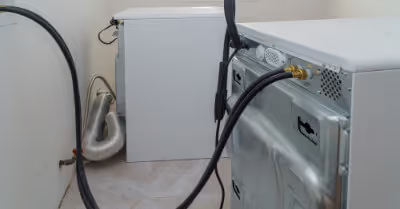Table of Contents
What Are Grass Runners?
Runners, or stolons, look like vines and grow horizontally above the ground. The term runner often also refers to rhizomes. Rhizomes grow horizontally, like stolons do, but they are underneath the surface of the ground.
Grass runners can be transferred from one yard to grow a new lawn. It is a good alternative to sodding or seeding and can even be used to patch up a yard. As the runners and stolons grow, they form more and more nodes. These nodes are the points where new grass will grow.
The term grass runner usually refers to either sprigs or plugs. Sprigs are pieces of runners that resemble vines or stems. They are about 3 inches to 6 inches long. Plugs are similar, but have soil around the roots.
Plugging is a great way to fix dead spots in your yard. It is cost effective and works quickly. Sprigging is a good option for repairing a large portion of a lawn or establishing a new yard. Sprigs require more maintenance and care than plugs, but work well when done correctly.
When Should You Plant Runners?
When you should plant runners depends greatly on where you live. Warm-season grasses grow best when the temperature is around 75 to 80 degrees Fahrenheit. Cool-season grasses do better when it is 60 to 75 degrees Fahrenheit.
The best time to plant runners is usually Spring to early Fall. Make sure not to start them in extreme temperatures. It is also best to determine an estimate of the temperatures for about 3 weeks after planting to ensure the climate won’t hinder their growth.
How To Remove Runners
You may be able to purchase trays of plugs from your local garden store. Some even have sprigs, but why buy them when you can transfer them. You should find the healthiest sprigs that have nodes on them already. They will grow more, but you want to start with quality sprigs.
You can use garden shears or garden scissors to cut the sprigs off. You want to try to get ones that have grown to at least three inches. You can get them longer, but try to avoid pieces longer than 6 inches.
How to Plant Plugs
Plugs are easy because you can buy them and they don’t require as much maintenance and care as sprigs.
All you will need:
- Plugs
- Shovel
- Fertilizer
- Compost and/or organic matter
- Rake
- Water
When you buy plugs, you should plant them as soon as you can. If you can’t plant them immediately, make sure that you keep them moist.
You need to prepare the area where you will plant them first. Remove excessive thatch and any rocks or other debris. Mix compost, organic matter, and fertilizer into the soil. Then use a rake to even it out.
Dig an individual hole for each plug. The holes need to be large enough to hold the entire root system. Plant the plugs in a grid pattern. The closer they are to one another, the faster the lawn will fill out.
Weed tend to grow between them in the empty soil. Eliminate them as soon as they appear so that their roots don’t take over. Water one to two times every day. Once the grass is three inches tall, you should mow. This will make them grow faster.
How to Plant Sprigs
Sprigs are cheaper than plugs and you can probably acquire them for free by asking a neighbor or friend. Sprigs, like plugs, should be kept moist until planted. There are a few different ways that you can adequately use the sprigs to establish or repair a lawn.
What you will need:
- Sprigs
- Water
- Rake
- Hoe
- Shovel
- Fertilizer
- Soil
- Compost and/or organic matter (optional)
- Lawn roller (optional)
- Rototiller or cultivator (optional)
Grid Pattern
This method is similar to the method for planting plugs because they both use a grid pattern. This is the most time consuming way to plant sprigs because you have to dig individual holes for each one.
First, you will have to remove any rocks and debris. It is also a good idea to check the soil for any large roots. Then, you should use a cultivator or shovel to loosen up the soil. Mix in fertilizer, compost, or organic matter.
You will want to plant the sprigs with the node above the soil. You can dig holes about three inches deep for each one. Dig them in a grid pattern for quicker results. After you plant them, it is best to walk over the area or go over it with a lawn roller.
You need to water the area often. Keep the sprigs moist at all times. You may notice weeds popping up in between the sprigs. Always remove them as soon as you see them. If needed, you can add some additional soil to level the areas between the sprigs out. This will help them grow quickly and correctly .
Furrow Method
This method works well, but doesn’t take as long as digging individual holes for each one of your sprigs. The methods are basically the same, but there are a few differences.
You will need to remove any stones or large roots that may inhibit proper growth. Then, you will dig a furrow, or trench. The furrows should be about three inches deep and you should make sure they are at least 4 inches a part. Don’t dig them more than 10 inches apart and the closer they are together, the faster the bare spots will be filled in with healthy grass.
The best tool to use to dig a furrow is a hoe, but you can use a shovel too. You will want to mix soil, fertilizer, and compost or organic matter together to fill in the furrows. Make sure that the nodes stay above ground while you fill in the holes.
Use a rake to even out the area and walk along it, or use a lawn roller to pack the dirt down. Make sure to not pack it down too much or water and air won’t be able to find their way to the roots of the grass.
Water the area as often as it takes to keep the area constantly moist. This could be up to 3 times a day in dry, hot climates. You also need to remove any weeds that pop up because they can get in the way of the runners.
Broadcast Method
This is the easiest and fastest way to plant sprigs. It isn’t quite as effective as other methods, but can still work well. First, you want to remove any rocks and debris from the area. Then, water the area so it is very moist, but not flooded.
Take your sprigs and place them over the prepared soil. Try to make sure they are evenly spread out so that they can take root without getting in the way of the others.
Now, take soil (you can mix in a small amount of fertilizer and compost or organic matter) and spread a small layer over the sprigs. Most of their roots should be able to grow into the soil and take hold.
You will want to level the area and walk on it or use a lawn roller. You will also have to water it often so that the sprigs remain hydrated. The soil should always be moist. When the sprigs grow to 3 inches, you should mow.
Recent Articles
















